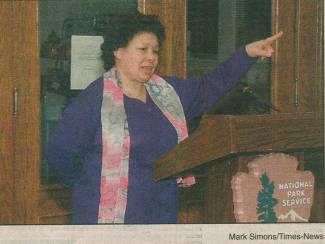Collection Name
About
Underground railroad was a do-or-die trip for slaves fleeing plantations of the South
MICHAEL A. SAWYERS
CUMBERLAND — The decision to begin travel on the underground railroad was one of desperation, according to Kimberly Rolls, a Keyser, W.Va., resident who spoke about the runaway slaves at a gathering Thursday night at the Western Maryland Station Center in honor of Black History Month.
"As they worked in the fields the slaves would say things such as 'heal away' or 'follow the north star,'" Rolls said. "These were signals that they would be leaving and trying to make it through the underground railroad to Canada, the only place they could be free."
Rolls' presentation was sponsored by the C&O Canal National Historical Park. The National Park Service is researching the underground railroad, trying to find an appropriate way and place to commemorate the Civil War era phenomenon.
Not all slaves tried to escape to the North, according to Rolls. Those in Texas fled for Mexico. Some in the Deep South headed to the West and others sailed for the Caribbean.
"The slaves would rather risk dying than to stay on the plantations," Rolls said.
Rolls spoke of Harriet Tubman, the slave well-known for her 19 clandestine trips back to the South to bring up to 300 slaves to freedom.
"There were helpers along the way who provided safe places to stay. They were known as conductors," Rolls said.
Rolls, who is employed by the West Virginia Division of Highways, is a member of the Allegany County Chapter of the NAACP and also the Mineral County Concerned Citizens on Racism.
Rolls said portions of the underground railroad are well known, but others may never be known. The railroad included paths, roads, rivers and even tunnels. "Some of it is lost history," she said.
Rolls said she has always heard that slaves traveled up the C&O Canal and stayed hidden in tunnels beneath the Emmanuel Episcopal Church on Cumberland's Washington Street.
An audience member said she believed there is a tunnel in Frostburg that runs from the site of Bogie's Restaurant to the Elks Club.
Rolls said it has been well documented that slaves used the C&O Canal from Washington D.C. to Hagerstown, but apparently left it at that point to travel northward into Pennsylvania and New York.
"The Slave Fugitive Law made it illegal to hide runaways in the northern states. That's why Canada was the final destination," Rolls said.
Rolls said she hopes that people will be alert for any information about the movement of runaway slaves in western Maryland. That information could come in the form of old diaries or other odds and ends that show up at places such as yard sales, she said. That information could be shared with the appropriate researchers by contacting the National Park Service or even taking it to a local library.
Another rumor that Rolls has heard for years is that a plantation style house on Bedford Road near Cumberland was a hiding * place for travelers on the underground railroad.
"Just think about Wills Creek and The Narrows. That would be an obvious route for anyone leaving this area," Rolls said.
Rolls said that once a slave started down the underground railroad there was no turning back.
"The guides wouldn't allows them to go back, even if it meant their death, because they knew if they returned to the plantation they would have the truth beaten out of them," she said.
The underground railroad operated from 1850 to 1865.
Photograph of Rolls by Mark Simons, Cumberland Times-News. Historian Kimberly Rolls, Keyser, W.Va., discusses the underground railroad at the Western Maryland Station Center.
